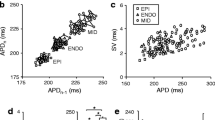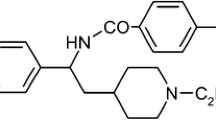Abstract
The class III agents d-sotalol and dofetilide have been shown to exhibit differential effects in large controlled clinical trials. The aim of this study was to investigate the basic electrophysiological properties of these two antiarrhythmia agents in an in vitro experimental model with regard to potential antiarrhythmic and proarrhythmic action. Using standard microelectrode techniques, we evaluated the electrophysiological effects of d-sotalol and dofetilide on action potential parameters recorded from guinea pig papillary muscle at 2.5 mM, 3.5 mM, and 5.6 mM extracellular potassium concentrations. The following parameters were recorded: resting membrane potential (RMP), action potential amplitude (APA), action potential duration at 90% repolarization (APD 90), and maximum upstroke velocity (Vmax). Under all conditions studied, both d-sotalol and dofetilide exhibited highly selective reverse rate-dependent class III action. In contrast to dofetilide, the class III activity of d-sotalol was markedly influenced by changes in extracellular potassium concentrations, predominantly at low pacing rates. Hypokalemia enhanced the action potential–prolonging effects of d-sotalol, whereas hyperkalemia diminished this effect. In addition, reverse rate dependence associated with dofetilide was significantly more pronounced than reverse rate dependence associated with d-sotalol. Our observations provide a potential electrophysiological basis for differential antiarrhythmic and proarrhythmic mechanisms associated with these two drugs.
Similar content being viewed by others
References
Kiehn J, Villena P, Beyer T, Brachmann, J. Differential effects of the new class III agent dofetilide on potassium currents in guinea pig cardiomyocytes. J Cardiovasc Pharmacol 1992;24:566-672.
Sanguinetti MC, Jurkiewicz NK. Two components of cardiac delayed recitifier K+ current. Differential sensitivity to block by class III antiarrhythmic agents. J Gen Physiol 1990;96:195-215.
Hiromasa S, Coto H, Li ZY, Maldonado C, Kupersmith J. Dextrorotatory isomer of sotalol: Electrophysiologic effects and interaction with verapamil. Am Heart J 1988;116: 1552-1557.
Carmeliet E. Voltage-and time-dependent block of the delayed rectifier K+ current in cardiac myocytes by development. J Pharmacol Exp Ther 1992;262:809-817.
Wettwer E, Grundke M, Ravens U. Differential effects of the new class III antiarrhythmic agents almokalant, E-4031, and d-sotalol, and of quinidine, on delayed rectifier currents in guinea pig ventricular myocytes. Cardiovasc Res 1992; 26:1145-1152.
Waldo AL., Camm AJ, de Ruyter H. Survival with oral d-sotalol in patients with left ventricular dysfunction after myocardial infarction: Rationale, design, and methods (the SWORD trial). Am J Cardiol 1995;75:1023-1027.
Kaber L Dofetilide, a new class III antiarrhythmic drug reduces hospital admissions for congestive heart failure-secondary endpoints of the DIAMOND-CHF study (abstr) J Am Coll Cardiol 1998;(Suppl.A):33A:1015-1039.
Cobbe SM, Manley BS. Effects of elevated extracellular potassium concentrations on the class III antiarrhythmic action of sotalol. Cardiovasc Res 1985;19:69-75.
Yang T, Tande PM, Lathron DA, Refsum H. Effects of altered extracellular potassium and pacing cycle length on the class III antiarrhythmic actions of dofetilide (UK-68,798) in guinea pig papillary muscle. Cardiovasc Drugs Ther 1992;6:429-364.
Yang T, Roden DM. Extracellular potassium modulation of drug block of IKr - Implication for torsade de pointes and reverse use dependence. Circulation 1996;93:407-411.
Carmeliet E K+ channels in cardiac cells: Mechanisms of activation, inactivation, rectification and [K+]e sensitivity. Pflügers Arch Pharmacol 1989;414(Suppl.1):S88–S92.
DiFrancesco D, Noma A, Trautwein W. Kinetics and magnitude of the time dependent potassium current in the rabbit sinoatrial node. Effect of external potassium. Pflügers Arch Pharmacol 1979;381:271-279.
Hondeghem LM, Snyders DJ. Class III antiarrhythmic agents have a lot of potential but a long way to go. Reduced effectiveness and dangers of reverse use dependence. Circulation 1990;81:686-690.
Gintant GA. Two components of delayed rectifier current in canine atriumand ventricle -Does IKs play a role in reverse rate dependence of class III agents? Circ Res 1996;78:26-37.
Weidman S. Shortening of the cardiac action potential due to a brief injection of KCl following the onset of activity. J Physiol 1956;132:157-163.
Carmeliet E, Vereecke J, Lieberman M. Horres, R. Potassium efflux as a function of age and external potassium concentration in the chick embrionic heart. Arch Int Physiol Biochim 1973;81:546.
Dreifus LS, Azevedo IM de, Watanabe Y. Review: Electrolyte and antiarrhythmic drug interaction. Am Heart J 1974;88:95-107.
Scamps F, Carmeliet E. Effect of external K+ on the delayed K+ current in single rabbit Purkinje cells Pflügers Arch 1989;414(Suppl.):S169-S170.
Sanguinetti MC, Jurkiewicz NK. Role of external Ca2+ and K+ in gating of delayed rectifier K+ currents. Pflügers Arch 1992;420:180-186.
Hafner D, Berger F, Borchard U, Kullman A, Scherlitz A. Electrophysiological characterization of the class III activity of sotalol and its enantiomers. Arzneimittelforschung/Drug Res 1988;38:231-236.
Wettwer W, Scholtysik G, Schaad A, Himmel H, Ravens U. Effects of the new class III antiarrhythmic drug E-4031 on myocardial contractility and electrophysiological parameters. J Cardiovasc Pharmacol 1991;17:480-487.
Baskin EP, Lynch JJ, Jr. Comparative effects of increased extracellular potassium concentration and pacing frequency on the class III activities of methanesulfonanilide IKr blockers dofetilide, d-sotalol, E-4031, and MK-499. J Cardiovasc Pharmacol 1994;24:199-208.
Carmeliet E. Use-dependent block of the dealayed K+ current in rabbit ventricular myocytes. J Cardiovasc Drugs Ther 1993;7(Suppl.3):599-604.
Lazzara, R. Antiarrhythmic drugs and torsade de pointes. Eur Heart J 1993;14(Suppl.H):88-92.
Roden DM. Early afterdepolarizations and torsade de pointes: Implications for the control of cardiac arrhythmias by prolonging repolarization. Eur Heart J 1993;(Suppl.14) H:56-61.
Author information
Authors and Affiliations
Rights and permissions
About this article
Cite this article
Marschang, H., Beyer, T., Karolyi, L. et al. Differential Rate and Potassium-Dependent Effects of the Class III Agents d-Sotalol and Dofetilide on Guinea Pig Papillary Muscle. Cardiovasc Drugs Ther 12, 573–583 (1998). https://doi.org/10.1023/A:1007743521932
Issue Date:
DOI: https://doi.org/10.1023/A:1007743521932




